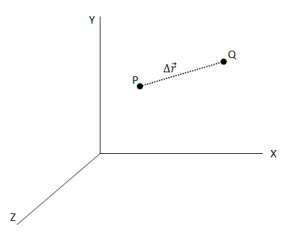In this article learn about what is Gradient of a scalar field and its physical significance. We have also written an article on scalar and vector fields which is the topic you must learn before doing this topic.
The gradient of a scalar field
Let us consider a metal bar whose temperature varies from point to point in some complicated manner. So, the temperature will be a function of x, y, z in the Cartesian coordinate system. Hence temperature here is a scalar field represented by the function T(x,y,z). Since temperature depends on the distance it could increase in some directions and decrease in some directions. It could increase or decrease rapidly along with some directions in comparison to other directions. Here we are interested in the rate of change of temperature $T$ with distance as we move away from the starting point.
Suppose we have two points P and Q separated by a small interval $\Delta \vec r$ as shown below in the figure.

Let T1 be the temperature of point P and T2 be the temperature of point Q. So difference in temperature of point P and Q is $\Delta T = {T_2} – {T_1}$ . Since $\Delta T$ is scalar and does not depend on the choice of the co-ordinate system so we can conveniently choose a set of the axis so that we could write
${T_1} = T\left( {x,y,z} \right)$ and ${T_2} = T\left( {x + \Delta x, y + \Delta y, z + \Delta z} \right)$
Where, ${\Delta x}$, ${\Delta y}$ and ${\Delta z}$ are components of vector $\Delta \vec r$.
By a theorem of partial derivatives, the difference in values of T at two neighboring points can be written as
\begin{equation}
\Delta T = {{\partial T} \over {\partial x}}\Delta x + {{\partial T} \over {\partial y}}\Delta y + {{\partial T} \over {\partial z}}\Delta z
\end{equation}
Above equation (1) tells us how temperature T of metal bar changes when all three co-ordinates changes by an infinitesimal amount ${\Delta x}$, ${\Delta y}$ and ${\Delta z}$.
The left side of equation 9 is clearly a scalar and right side of equation 9 seems to be the dot product of two vectors and hence equation 9 can also be rewritten as
$$\Delta T = \left( {\hat i{{\partial T} \over {\partial x}} + \hat j{{\partial T} \over {\partial y}} + \hat k{{\partial T} \over {\partial z}}} \right) \bullet \left( {\hat i\Delta x + \hat j\Delta y + \hat k\Delta z} \right)$$
\begin{equation}
\Delta T = \left( {\nabla T} \right) \bullet \left( {\Delta \vec r} \right)
\end{equation}
Where,
\begin{equation}
\nabla T = \left( {\hat i{{\partial T} \over {\partial x}} + \hat j{{\partial T} \over {\partial y}} + \hat k{{\partial T} \over {\partial z}}} \right)
\end{equation}
is known as the gradient of $T$. Clearly $\nabla T $ is a vector quantity derived from the scalar field. So, equation (2) tells us that the difference in temperature between two neighboring points is the dot product of the gradient of T and the vector displacement between points.
Since gradient of any scalar field is a vector it like other vectors have magnitude as well as direction. Rewriting the dot product in equation (2) we have,
\begin{equation}
\Delta T = \nabla T \bullet \Delta \vec r = \left| {\nabla T} \right|\left| {\Delta \vec r} \right|cos\theta
\end{equation}
Where $\theta$ is the angle between $\nabla T$ and $\Delta \vec r$. If we fix the length of$\Delta \vec r$ and let it have arbitrary direction the value of $\left( {\nabla T} \right) \bullet \left( {\Delta \vec r} \right)$ is maximum when $\Delta \vec r$ is along the direction of $\nabla T$ and it occurs when $\theta = 0$ giving $cos\theta = 1$.
So if we move along the same direction as the gradient then function T changes maximally. So the direction of $\nabla T$ is along with the greatest increase of T. The magnitude $|\nabla T |$ gives the slope along this direction as can be seen that each component of $\nabla T$ clearly gives a slope.
The $\nabla$ operator
Consider the expression 3 from the previous section which is
$\nabla T = \left( {\hat i\frac{{\partial T}}{{\partial x}} + \hat j\frac{{\partial T}}{{\partial y}} + \hat k\frac{{\partial T}}{{\partial z}}} \right) = \left( {\hat i\frac{\partial }{{\partial x}} + \hat j\frac{\partial }{{\partial y}} + \hat k\frac{\partial }{{\partial z}}} \right)T$
The term in the parenthesis is known as del operator ad is given by
$\nabla = \left( {\hat i\frac{\partial }{{\partial x}} + \hat j\frac{\partial }{{\partial y}} + \hat k\frac{\partial }{{\partial z}}} \right)$
So, this is a vector operator and as such it does not have a meaning until it is made to operate on a function. We have already seen what happens when this operator acts on a scalar function say $\Phi \left( {x,y,z} \right)$ then
$\nabla \Phi \left( {x,y,z} \right) = grad \Phi$
and it gives a gradient of this scalar function.
This operator acts on a vector function in two possible ways
- Via dot product: $\nabla \cdot \vec v$ which gives divergence of the vector function
- Via cross product: $\nabla \times \vec v$ which gives curl of a vector function.
